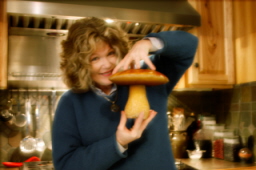We're having fun now! The bread baking mentors of this community have been so generous with their advice and encouragement. It's starting to come together in my kitchen. I baked a sourdough no knead using notes by JMonkey and Susan this week and here is the result-

Dutch Oven Sourdough
I was elated when I saw this crackley crust. Where you accomplished baker's would scowl and say "that D@^^%loaf (say, I accidently created a new domain name) tore all to #&!!" I say "that lower quadrant is looking good!" If Susan's beautiful boule is "the football", I think this is at least a foosball. And the crumb. Anticipation and dread. Do you ever feel that way?-

Sourdough Crumb
I like it. It pleases my sense of aesthetic beauty. Yes, it is toothsome. I know you think the holes could be placed more uniformly but I am giddy with my small success and may be beyond help from this day forward.
This loaf baked on a higher rack and at a slightly higher temperature in my really big oven. Bwraith and Mini Oven advised me on that. As a result I could follow the baking times exactly.
The sourdough starter was about 3 days at room temperature since the last feeding. We discussed this on the Sourdough starter thread and I've now learned that the starter really needs to be used at the peak of its yeasty goodness. In this case, the proof was in the proof; only about a 60% increase after 20 hours of fermentation. I used yet another tip and incorporated 1/8 tsp of instant yeast during the stretch and fold.
Susan wrote "Oh, I used all high gluten flour". I think this really made a difference. The dough was smooth, elastic and held tension in the forming. The texture is exactly what I'm looking for in carefully crafted bread. Although I had planned to refrigerate the formed dough overnight, we had guests so went to plan B, 3 hours proof at 85 degrees.
I really wanted to be faithful to the formula, but my lab technique is imprecise (read- a joke). There are plenty of other things to improve upon. Slashing could certainly head a list; a long, long list!
Thanks to all the sourdos (the ugh is silent), guy, lady and the rest. You rock! I also must thank the dogs, brown and mountain, for their cyber-enthusiasm. Bake-on, dogs!




















